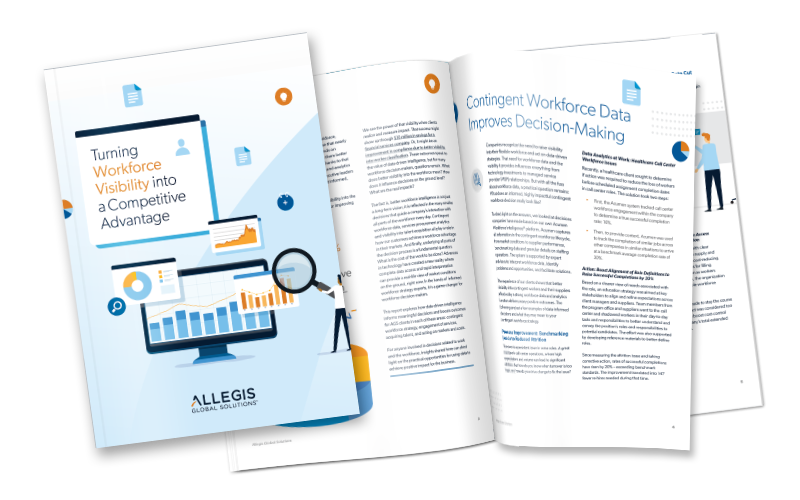Don't Confuse The Universal Workforce Model with Total Talent
The concept of ‘total talent’ has been around for many years – that a single provider or service could provide contingent, services procurement (SOW) and permanent staffing, leading to a streamlined, better controlled and more effective talent platform. It’s mainly a concept as few companies have had both their managed service provider (MSP) and recruitment process outsourcing (RPO) divisions run by the same provider. And even for those that work with a single workforce solutions provider for MSP and RPO, it has seldom provided the promised vision of a harmonised and streamlined offering.
 Part of this initial challenge is that while AGS’ Procurement Solutions product is top-performing, the concept of managing SOW service providers in a similar way to staffing suppliers is relatively new to the market. Therefore, some companies find it hard to move beyond on-/off-boarding workers under an SOW to true management of services.
Part of this initial challenge is that while AGS’ Procurement Solutions product is top-performing, the concept of managing SOW service providers in a similar way to staffing suppliers is relatively new to the market. Therefore, some companies find it hard to move beyond on-/off-boarding workers under an SOW to true management of services.
What’s needed instead is new thinking about how work gets done, how it’s managed, and a clear direction on data capture and analysis. I have some ideas about that and why AGS aims to take organisations on a journey to harmonised workforce strategy and management through the Universal Workforce Model™ framework. But total talent it is not.
What is Total Talent? For Starters, It’s Not a Blueprint
The first issue is really defining total talent as a specific and tangible strategy. What is it? What does it contain? Is combining MSP and RPO under one provider total talent? Or, is it about a single source of data – or both? Because no clear definition exists, total talent is just a concept or idea without any form or function.
What is real, however, is that there is an absolute hunger for change and transformation – but how and with what? As much as it seems like no single voice has effectively prescribed the solution, all are well-aligned on the problem statement: a lack of cohesion and business silos lead to an inconsistent workforce strategy that increases costs and risks, and negatively impacts the bottom line.
So, it’s a good starting point to identify the problems with a nonunified workforce, a term to wrap around a complex challenge. One answer is the Universal Workforce Model. As an agile and outcome-based framework, the Model provides a structured approach to how organisations can begin the journey to shift workforce paradigms. More importantly, it creates the platform for discussion and conversation at the level most needed for change on this scale – the C-suite of an organisation.
Total Talent: A Marriage of Convenience
A quick scan of the services market will almost universally say that total talent is the blending or merging of MSP and RPO models to combine data and open multi-channel sourcing possibilities.
The problem starts there.
The models of MSP and RPO are now so siloed, in both their ecosystem and process constructs, such that any cohesion requires a well-conceived intermediary platform and strategy. Whilst talent acquisition (or RPO) is universally owned by the human resources (HR) department, MSP can be managed either within a procurement or HR team, although it’s largely the former. This means that the objectives and data to support those objectives are going to look and feel differently from the HR strategy. So, before there can be a question on ‘how’ we collect data, the question has to be ‘what’ data are we collecting now, and how does that weave together for a consistent data set?
In addition, the burgeoning consultant (or services) spend that organisations have has the full attention of the C-suite. A post-pandemic boom of contingent and outsourced relationships means a strategy that hopes to create visibility and control must include this high spend category. It isn’t ‘talent’ in its traditional sense, but it is how ‘work gets done,’ so it must include a deep understanding and assimilation of this important organisational infrastructure.
In January 2021, a Fortune/Deloitte survey found that only 33% of CEOs said their supply chain needed to change. Nearly all respondents in their updated survey fielded in January 2022 said they would take action on their supply chains in the next 12 months.
The Universal Workforce Model gives true understanding of how work gets done rather than focusing on just the talent a business already has. We believe that the traditional models need to be recalibrated for a modern world focused on hyper-mobility, tasks and engaging all forms of available resources to get work done.
Data Beyond Demand Planning?
There are, of course, some more naturally common threads of data that could yield some insights – cost of labour, the number of permanent and contingent individuals currently employed, attrition, etc. These can provide some interesting insights into expectations and demand planning. Perhaps the easiest of these is recognising if a contractor should, in fact, be a permanent employee. Their cost, tenure and work might be more efficiently managed as a permanent employee, especially if there are vacancies available as a full-time equivalent, where a contractor is finishing their assignment.
That’s a very practical use case, but beyond the real-time data of performance, however, what strategy could be employed to really harmonise the workforce, and what data would you need? The key challenges of the day – diversity, equity and inclusion; cultural cohesion; and wellbeing – must be strategically enabled through the data and tools for a model to be successful.
There are widespread growing pains within the traditional models of workforce enablement (e.g., translating strategy around skill shortages, diversity and workforce cohesion). The Universal Workforce Model is the North Star for organisational change. Download “The Universal Workforce Model: An Outcome-Based Guide to Getting Work Done” and be part of the conversation on changing the industry.






